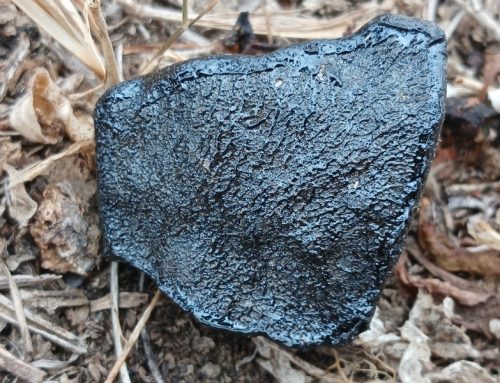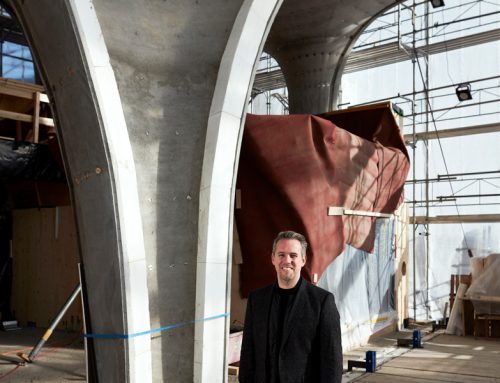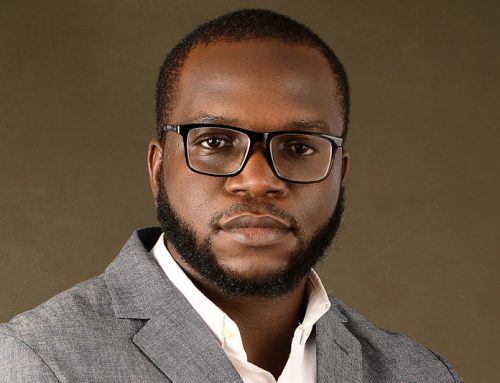 The arid landscape of Carnarvon in the Northern Cape, where the Square Kilometre Array (SKA) radio telescope is being built, is watched over by quiver trees. Sentries from another time, these silent giants date back to the ancient world of the Khoisan and still further back to an age before any human footprints passed this way.
The arid landscape of Carnarvon in the Northern Cape, where the Square Kilometre Array (SKA) radio telescope is being built, is watched over by quiver trees. Sentries from another time, these silent giants date back to the ancient world of the Khoisan and still further back to an age before any human footprints passed this way.
It’s a world that SKA SA Project Director Dr Bernie Fanaroff has come to know well. A world that reminds us we live on a planet and in a universe that has witnessed far more than we will ever know. It is a fitting location for this “fantastic machine”, as Professor Sergio Colafrancesco, SARChI SKA Chair in the Wits School of Physics, calls the SKA.
“This fantastic machine will allow us to study how and where the very first structures in the universe were formed,” Colafrancesco explains.
Far larger and approximately 50 times more sensitive than present-day radio telescopes, it will probe further and deeper than ever before. It will take us back over 13-billion years to the beginning of time as we know it, and help to answer some of science’s most far-reaching questions, including: What is dark matter? What is dark energy? Are we alone?
“It will allow us not only to understand the physics and the evolution of the universe and its structures, but also to follow the route of the first structures and fill in the gaps lacking in our current understanding of cosmic history,” Colafrancesco elaborates. “It will also allow us to study new aspects of astrophysics, like the origin of extremely high-energy particles, cosmic jets, black holes and the structure and evolution of magnetic fields in cosmic structures.”
This fantastic machine is the biggest scientific project Africa has ever undertaken, and the man who was instrumental in making it all happen and is now leading the project is Fanaroff, who has been working on getting it to this point for the past nine years.
“With the site bid completed we are going into the more intensive work of finalising the design and technology of the telescope,” says Fanaroff in a voice as calm as a quiver tree in the moonlight. “A large amount of construction is going on at the Carnarvon base site now and we already have seven dishes up and running. We are using them as a learning prototype and doing science with them.”
He is as excited as everyone else about the project but he keeps his feet on the ground as it is up to him to steer the SKA to success – from helping to secure funding, to ensuring its construction is on track, to guiding the socio-economic and educational benefits and collaborations that are part of the project.
Scientists, engineers and industry partners from around the world are participating in the SKA project, for which money will be raised from multiple international funding agencies and countries.
The cost of the SKA project is quoted at R15-billion. “Actually we expect that it will land up being more like R25-billion, and then there are the operational costs of about R2-billion a year,” explains Fanaroff.
Now based in Cape Town as the SKA head office is in Pinelands, this Joburger is missing his home city, where he lived for 64 years. He studied physics at Wits and graduated in 1970 with a BSc Hons in Theoretical Physics, followed by a doctorate in radio astronomy at Cambridge, which he received in 1974. He worked as a radio astronomer for a number of years and is renowned in astronomy circles for a breakthrough he and British astronomer Julia Riley made in 1974 in an extremely important classification of radio galaxies, called the Fanaroff-Riley classification.
Capable of wearing many hats with this quiet brand of clout, Fanaroff was also a trade union leader for 15 years, and the first Director General in the RDP Ministry under Jay Naidoo. The list goes on, but let’s leave it at that and focus on the giant cosmic fish he now has to fry with the SKA on his hands.
“In addition to the design, technology and finance side, we’re currently working on the hosting and funding agreements, as well as on the completion of the MeerKAT (SKA’s precursor) and associated infrastructure.”
Fanaroff and his team would naturally have preferred to win the whole bid, but he says they’re happy to be the major player, with the two most important components of the SKA in Africa: the 2 500 satellite dishes and the mid-frequency aperture arrays. Australia will host the hundreds of low-frequency antennae.
“It shows great confidence in Africa,” says Fanaroff, adding that the longer-term goal of the SKA project is to build South Africa into a leader in science and technology.
The influence of the project extends way beyond radio astronomy. It will catalyse technology and green energy development, data transport, software and computing. It is also expected to stimulate skills development, employment and economic growth in South Africa.
“We can’t solve all of South Africa’s problems,” he smiles, “but what we can do is provide a pipeline that produces the astronomers and engineers that are required for the project.” The project has already provided 425 grants for MSc and PhD research directly related to the physics, astronomy and engineering aspects of the SKA. Of these, 375 have been awarded for study in South Africa to undergraduates in physics and engineering, and for the training of technicians.
“Our support for undergraduates studying physics and engineering focuses on black and women students, because we weren’t getting sufficient numbers of these students into the postgraduate programmes,” Fanaroff explains.
The other 50 grants are for students from other African countries – many have now started astronomy courses at universities in their home countries.
The SKA’s 2 500 satellite dishes will be positioned across Africa: 1 800 at the Karoo site and the rest in Namibia, Botswana, Zambia, Mozambique, Ghana, Kenya, Madagascar and Mauritius. The SKA South Africa project is also working with several other African countries on the AVN, or African Very Long Baseline Interferometry Network, which aims to convert redundant satellite communications dishes for astronomy.
On the post-doctoral front the SKA project is supporting research in South Africa for a number of researchers from local and international universities. Wits and the other South African universities that are involved in the SKA and hold SKA Chairs are collaborating in the research.
The SKA project also has a technician-training programme and is working with the Durban University of Technology and the FET College in Kimberley to train technicians to work on the project. “We will have an immense need for technicians and artisans. The FET College in Kimberley is training people from the Carnarvon/Williston/Van Wyksvlei area in artisan skills. The first group has graduated and most of them will be employed at the Karoo site, working on various aspects of construction: from bricklaying and electrical work to plumbing. The minimum qualification for the FET College is a matric, and we have now taken a second, larger group to Kimberley for training.”
To boost the science and mathematics ability of learners at school in and around Carnarvon, the SKA project is supporting the science and mathematics teachers, and it has provided a science and computer lab. “Good maths and science teachers can secure a job anywhere, which makes it difficult to convince them to take up posts in such a remote area, but we are managing, which is starting to make a difference to the numbers of science and maths matriculants,” says Fanaroff.
The SKA project aims to employ as many South Africans as possible. A large contract to build 64 MeerKAT dishes as a precursor to the SKA that was recently awarded, includes a commitment from the company, Stratosat, that at least 75% of the construction will be done in South Africa, with accompanying skills transfer. Stratosat will also have a corporate social investment programme in the Carnarvon area.
The MeerKAT telescope, comprising 64 dishes, will be completed by 2016; the SKA will be completed by 2024. Ten international scientific teams, which include South African scientists, have been allocated time for large surveys on the MeerKAT, and they are helping to develop the software tools and all the other aspects the surveys will require.
Human capital and human collaboration is essential to the project’s success. This includes the farming community around the SKA core site.
Fanaroff says they have been involved in protracted discussions with the local communities and farmers. One of the issues is communication. While the SKA will be looking back to the beginning of time, communication links for people living on farms in the Carnarvon/Williston/Van Wyksvlei area are poor.
“The farming communities here used to have a fixed line service from Telkom but this has largely collapsed,” Fanaroff explains. “A few of the farmers have mobile phone connections, usually with a poor signal, but the requirements for protection of the radio environment in the area will in the future restrict the use of cellphone access. To resolve this issue, we’re working with the farming communities and the telecommunications operators on alternative communication technologies.”
A benefit of the SKA to farmers is that it will certainly take precedence where shale gas fracking is concerned. “The Minister has specified that any mining or fracking activities that interfere with the telescope will not be permitted,” Fanaroff says.
The SKA project has also increased the value of property and land in Carnarvon, and triggered a B&B boom. “A few years ago you could buy a house there for R65 000; now these same houses are selling for R800 000 and there aren’t any available. We have had to build construction camps to supplement the B&B offerings, which have significantly increased in number. They’re all full,” says Fanaroff, who greatly appreciates the area. “I love the quiver trees and the Karoo succulent biome and the vastness and quietness of the area.”
Taking in all this vastness and the leagues of outer space that the SKA will explore, Fanaroff is filled with the wonder and magnitude of it but he does not believe there is a God out there making sure we’re not alone.
“I’ve been an atheist since the day I was born,” he says. “I’m interested in science, not religion.” Asked whether he doesn’t at least question what happens when you die, he replies: “You die.” And this finite ending, without any reassurance of heading for heaven, doesn’t make him feel insecure. “I don’t often feel insecure,” he states. He is not being arrogant, he’s just being straightforward, which is how Fanaroff is. “The one thing that gets to me is I hate travelling and I do it a lot. I am insecure about missing flights.”
Between flights all over the world, journeys to the Northern Cape and the universe on his shoulders, Fanaroff has little time to himself. When he can snatch a few hours or days he enjoys going to the theatre, visiting the game parks and the Garden Route and walking his dog. And so it is that on a calm Cape Town afternoon, you might spot the man behind the fantastic machine walking his border collie along the esplanade.




